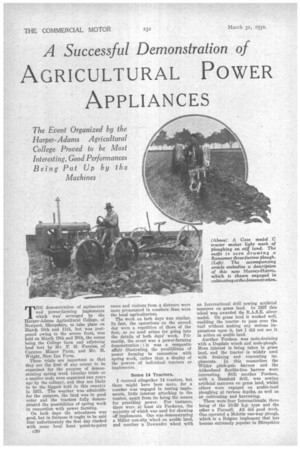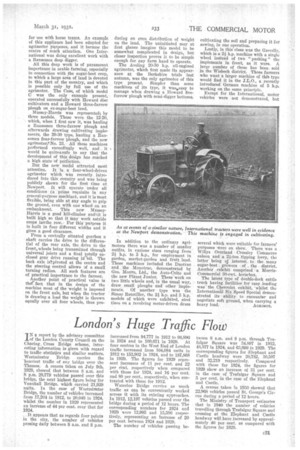A Successful Demonstration of
Page 52

Page 53

If you've noticed an error in this article please click here to report it so we can fix it.
AGRICULTURAL POWER APPLIANCES
The Event Organized by the Harper-Adams Agricultural College Proved to be Most Interesting, Good Performances Being Put Up by the Machines
TUE demonstration of agrimotors and power-farming implements which was arranged by the Etarper-Adams Agricultural College, of Newport, Shropshire, to take place on March 10th and 11th, but was postponed owing to the severe frost, was held on March 19th and 20th, the venue being the College farm and adjoining land lent by Mr. F. M. Furniss, of Cayuton Manor Farm, and Mr. H. Wright, New Inn Farm.
These trials are important in that they are the first of any extent to be 'organized for the purpose of demonstratin‘, spring work (similar trials on a smaller scale were organized two years ago by the college), and they are likely to be the biggest held in this country in 1931. The weather was admirable for the purpose, the land was in good order and the tractors fully demonstrated the possibilities of spring work in connection with power farming.
On both days the attendance was good, but in fairness it ought to be said that unfortunately the first day clashed with some local hunt paint-to-point c30 races and visitors from a distance were more pronounced in numbers than were the local agriculturists.
The work on both days was similar. In fact, the operations on the second day were a repetition of those of the first, so no need arises for going into the details of both days' work. Primarily, the event was a power-farming demonstration ; t. it was a composite affair illustrating the possibilities of power farming in connection with spring work, rather than a display of the powers of individual tractors or implements.
Some 14 Tractors.
I counted altogether 34 tractors, but there might have been more, for a number was engaged in testing implements, little interest attaching to the tractor, apart from its being the means for providing power. For instance, there were at least six Fordsons, the majority of which was used for showing off implements. One was demonstrating a Miller non-slip 'wheel on arable land, and another a Dewandre wheel with
an International drill sowing artificial manures on grass land. In 1927 this wheel was awarded th_e R.A.S.E. silver medal. On grass land it worked well, enabling the tractor to pass over the turf without making any serious impressions upon it, but I did not see it in action on arable land.
Another Fordson was mole-draining with a Dugdale winch and mole-plough. More interest is being taken in grass land, and the tractor is widely used with draining and renovating implements. In this connection the Wilder pitch-pole harrow and the Aitkenhead flexible-tine harrow were interesting. Still another Fordson, with a Bamfield drill, was sowing artificial manures on grass land, whilst others were engaged on arable-land ploughing at various depths, as well as on cultivating and harrowing.
There were four Internationals, three being of the 10-20 h.p. type and the other a Fennell. All did good work. One operated a Melotte one-way plough, which is a Belgian implement that has become extremely popular in Shropshire for use with horse teams. An example of this appliance had been adapted for agrimotor purposes, and it became the centre of much attention. One International was doing excellent work with a Ransomes deep digger.
All this deep work is of paramount importance in arable farming, especially in connection with the sugar-beet crop, to which a large area of land is devoted in this part of the country, and which is possible only by full use of the agrimotor. The Case, of which model C was the only example present, operated successfully with Howard disc cultivators and a Howard three-furrow plough on ex-sugar-beet land.
Massey-Harris was representedt by three models. These were the 12-20, which, when I first saw it, was hauling
Ransomes three-furrow plough and afterwards drawing cultivating implements, the 20-30 type, hauling a RanBarnes four-furrow plough, and the new agrimotor0No. 23. All these machines performed exceedingly well, and _ it would be quite‘safe to say that ' the development of this de-sign has reached a high state of perfection.
But the new model attracted most attention. It is, a four-wheel-driven agrimotor which. was recently introduced into this country and was being publicly shown for the first time at Newport. It _will operate under all conditions (a prime requisite in any general-purpose machine), and it is most flexible, being able at any angle to grip the ground, even with one wheel on an embankment. This new MasseyHarris is a good hill-climber andlit is built high so that it may work astride crops intthe row.. For this purpose it is built in four different widths and it gives a good clearance.
From a centrally situated gearbox a shaft carries the drive to the differential of the rear axle, the drive to the front. wheels being transmitted through universal joints and a final totally en closed gear drive running The back axle islpivoted at the centre and the steering control allows of a small turning radius. All such features are of practical importance to the farmer.
Another point of practical value is tiler fact that in the design of the machine most of the weight is imposed on the front axle, but when the tractor is drawing a load the weight is thrown equally over all four wheels, thus pro dyeing an even distribution of weight on the land. The uninitiated may at first glance imagine this model to be somewhat complicated in design, but closer inspection proves it to be simple enough for any farm hand to operate.
The Aveling 20-30 h.p. oil-engined agrirnotor, which first made its appearance at the Berkshire trials last autumn, was the only agrimotor of this type present. Simpler than some machines of its type, it wask,easy to manage when drawing a Howard fivefurrow plough with semi-digger bottoms.
In addition to the ordinary agrimotors there was a number of smaller outfits, in various sizes ranging from h.p. to 5 h.p., for employment in garden, market-garden and fruit land. These machines included the Duotrac and the Monotrac, demonstrated by Geo. Mono, Ltd., the Auto-Culto and the new Planet Junior. These work on two little wheels and, in the usual way, draw small ploughs and other implements. Of another type was the Shrum Rototiller, the 2i h.p. and 5 h.p. models of which were exhibited, steel tines on a revolving motor-driven drum cultivating the soil and preparing it for sowing, in one operation.
Lastly, in this class was the Grevelly, which is a 2 h.p. machine with a single wheel instead of two " pushing " the implements in front, as it were. A large number of these has been. sold in the Wisbech district. Those farmers who want a larger machine of thfk type would find it in the j.L.O., a recently introduced German machine of 5 h.p. working on the same principle.
Except for the International, motor vehicles were not demonstrated, but
several which were suitable for farmers' purposes were on show. There was a Willys Overland Crossley Commerce saloon and a 2i.ton tipping lorry, the latter being of interest to the" many sugar-beet growers of the district. Another exhibit comprised a Morris
Commercial 30-cwt. horsebox. .
The latest type of double-deck cattle truck baying facilities for easy loading was' the Chevrolet exhibit, whilst the International Six Speed Special demonstrated its ability to encounter and negotiate soft ground, when carrying a heavy load. Aonnnor.












































































































